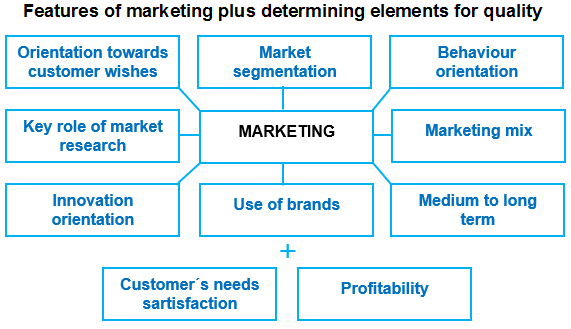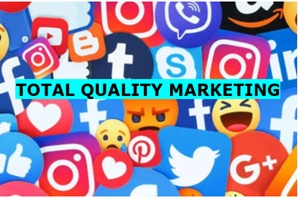- Home
- Levels of Quality Management
- Implementing total quality marketing
Implementing total quality marketing
How to influence higher quality based on marketing

The companies and individuals that offer a product or service aspire to provide quality products and / or services to their customers.
Quality is spoken of when dealing with the strategic objectives of organizations, regardless of type, sector, etc. Quality is understood as the set of properties and characteristics of a product or service that confer aptitude to satisfy specific needs of users.
It is around this aspect, focusing on the client where every quality model begins and ends, where we must ask ourselves: do we really know the client's needs?
For its part, marketing as a process implies the identification, forecasting and satisfaction of customer needs in a way that is profitable. Profitability is given by the adequacy of the results to the established objectives, which highlights its relationship with quality management.

Marketing
is therefore an adjustment process, a strategy to unite products and consumers,
the elements of which are:
*
Identification of customer needs.
* Satisfaction of customer needs.
* Profitability.

All the aspects of market orientation presented above require a comprehensive and powerful system for collecting and processing market information.
In general, continuous market observation (market growth, market share etc.) is combined with sporadic, targeted studies (buyer typologies, preference research, advertising effectiveness tests etc.).
A broad range of methods is now available in market research. In this context, it is worth emphasizing that market research not only lays the foundations for adapting the company to market conditions but also plays a key role in the endeavor of influencing and testing the market conditions.
efficiency and strategy in TOTAL QUALITY MARKETING

Marketing is an efficiency tool. Its main objectives are:
- Retain customer-users, that is, maintain their loyalty based on continuous improvements in everything that surrounds the product or service.
- Attract new customers-users.
It is about taking care of the client, advising him and providing him with something more than just the product, that is added value, and persuading him. The user of any service, but especially information services, is captivated not only by the product but by what surrounds him. We not only sell the information that we have or that we can access, but we sell ourselves, to the company.
This implies a review of the processes carried out in the information services, questioning whether the execution of each one of them adds value perceived by the user or if, on the contrary, it involves costs that do not imply value.
Lean tools are decisive to precede any aspect that may affect the determinants of marketing, especially knowing how to adapt demand to consumer needs, influence processes to add value and thereby eliminate implicit costs, together with being able to have information to give the customer that unexpected value that maximizes attraction and loyalty to the brand and the product.

Strategic supply chain integration is a key to powerful marketing. The integration of sales professionals, with purchasing managers and distributors is unanimous. The sales purchasing and distribution field has changed from one of inventory management and sales to a more holistic, value-added approach, featuring total quality management and value chain management.
Distributors and sales and purchasing professionals all agree that many factors led to these changes, but the main catalyst has been an emphasis on value-added services.
These
services are generally a physical adaptation to a product such as an optional stereo
for a car. Whereas the most important
demand that customers have for a product is for quality, their quality
requirements vary sharply according to the customer's size, needs, and the
extent to which the customer's own quality system has developed. For example,
the automotive industry demands quality from its distributors by monitoring
distributor nonconformance through such variables as delivery, product quality,
and administrative errors. Several priorities must be constantly looked at by
purchasing and distribution organizations for them to successfully embrace the
changes around them.
ASPECTS THAT INFLUENCE THE ABILITY OF A COMPANY TO MAKE USE OF MARKET OPPORTUNITIES ARE PRIMARILY:
- Current market share.
- Current relative market share (in relation to major competitors).
- Market share development.
- Size of the company.
- Financial strength of the company.
- Image of the company,
- Existing customer relationships.
- Operating margin.
- Expertise (research and development, production, marketing),
- Cost situation (economies of scale, experience curve etc.).
- Management quality.
advantages TOTAL QUALITY MARKETING

- A better understanding of the market and customer needs is achieved to provide the best service around their goals and therefore there is sustained growth in both business instances.
- It is easier to identify the market with accurate information and analyze the business for strategic development.
- It is easier to differentiate ourselves from the competition.
- Greater customer loyalty is achieved.
- Robust processes are generated that allow to identify with greater attachment each one of the elements of the system.
- Avoid adding elements that don´t add value to the business, reduce costs and seek greater profitability.
InArtifexYou has consolidated instructors on the subject that will allow you to influence
your company or project with a more sustained vision in terms of marketing in
integration with strategic planning tools and continuous improvement, seeking
to obtain the greatest impact on your goals.
Take a look to our international certification programs.
Welcome to InArtifex community!